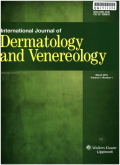- 钛学术文献服务平台 \
- 学术期刊 \
- 医药卫生期刊 \
- 皮肤病学与性病学期刊 \
- 国际皮肤性病学杂志(英文)期刊 \
A Study of Normal Epidermal Melanocyte Distribution
A Study of Normal Epidermal Melanocyte Distribution
基本信息来源于合作网站,原文需代理用户跳转至来源网站获取
摘要:
Objective::To elucidate the epidermal melanocyte distribution according to sex, age, and body part with the goal of providing benchmark data for the diagnosis and therapeutic effect evaluation of pigmentary skin diseases.Methods::Epidermal melanocytes and keratinocytes were assessed using direct immunofluorescence staining, and the melanocyte density and epidermal thickness were calculated. The obtained data were statistically analyzed using SPSS Version 20.0 software. An independent-samples
t test was used to compare the data between two groups, while data among three or more groups were compared by one-way analysis of variance. Data correlations were evaluated using Pearson correlation analysis.
Results::Melanocytes were uniformly distributed among the keratinocytes in the basal layer, and the average ratio of melanocytes to keratinocytes was 1:7. Among them, the ratio in males was 1:6.5 and that in females was 1:7.4, with no significant difference (
P= 0.127). The melanocyte density gradually declined as age increased; the ratio was 1:5.8 before 50 years of age without an obvious downtrend. The average melanocyte density was 1:7.9 within 51 to 65 years of age and 1:8.5 at >65 years of age, and the difference was statistically significant (
P < 0.01). Obvious differences were found in the melanocyte density among different body parts; in descending order, these densities were as follows: face (1:4.0) >neck (1:5.1) >hip (1:5.7) >upper limb (1:7.4) >lower limb (1:8.3) >lower back (1:9.2) >thorax and abdomen (1:9.9). The melanocyte density was not related to the epidermal thickness.
Conclusion::The melanocyte density showed a declining trend with age and significantly changed after 50 years of age. The melanocyte density was associated with body part; specifically, the density in the face, neck, and hip was higher than that in the limbs and torso. However, the melanocyte density was not associated with sex or epidermal thickness.

推荐文章
Altitude-dependent distribution of 137Cs in the environment: a case study of Aragats massif, Armenia
137Cs
Distribution by altitude
Naturally occurring radionuclides
Topsoil
Dry atmospheric depositions
Gamma radiation
Mountain regions
Distribution and geochemical significance of trace elements in shale rocks and their residual keroge
Shale
Kerogen
Trace elements
REEs
Effects of topography and vegetation on distribution of rare earth elements in calcareous soils
REE distribution
Weathering and pedogenesis
Topography and vegetation
Calcareous soils
Distribution and ecological risks of heavy metals in Lake Hussain Sagar, India
Trace metals
Lake sediment
Geochemistry
Speciation
Industrial effluents
Idol immersion
内容分析
关键词云
关键词热度
相关文献总数
(/次)
(/年)
文献信息
| 篇名 | A Study of Normal Epidermal Melanocyte Distribution | ||
| 来源期刊 | 国际皮肤性病学杂志(英文) | 学科 | |
| 关键词 | distribution immunofluorescence melanocytes | ||
| 年,卷(期) | 2021,(1) | 所属期刊栏目 | Brief Report |
| 研究方向 | 页码范围 | 32-35 | |
| 页数 | 4页 | 分类号 | |
| 字数 | 语种 | 中文 | |
| DOI | 10.1097/JD9.0000000000000125 | ||
五维指标
引文网络
引文网络
二级参考文献 (0)
共引文献 (0)
参考文献 (9)
节点文献
引证文献 (0)
同被引文献 (0)
二级引证文献 (0)
1957(1)
- 参考文献(1)
- 二级参考文献(0)
1963(1)
- 参考文献(1)
- 二级参考文献(0)
1979(1)
- 参考文献(1)
- 二级参考文献(0)
1985(1)
- 参考文献(1)
- 二级参考文献(0)
1989(1)
- 参考文献(1)
- 二级参考文献(0)
1999(1)
- 参考文献(1)
- 二级参考文献(0)
2008(1)
- 参考文献(1)
- 二级参考文献(0)
2015(1)
- 参考文献(1)
- 二级参考文献(0)
2017(1)
- 参考文献(1)
- 二级参考文献(0)
2021(0)
- 参考文献(0)
- 二级参考文献(0)
- 引证文献(0)
- 二级引证文献(0)
研究主题发展历程
节点文献
distribution
immunofluorescence
melanocytes
研究起点
研究来源
研究分支
研究去脉
引文网络交叉学科
相关学者/机构
期刊影响力
国际皮肤性病学杂志(英文)
主办单位:
中华医学会
出版周期:
季刊
ISSN:
2096-5540
CN:
32-1880/R
开本:
大16开
出版地:
江苏省南京市玄武区蒋王庙街12号
邮发代号:
28-6
创刊时间:
2018
语种:
chi
出版文献量(篇)
4444
总下载数(次)
15
总被引数(次)
10193
期刊文献
相关文献
推荐文献
- 期刊分类
- 期刊(年)
- 期刊(期)
- 期刊推荐
国际皮肤性病学杂志(英文)2022
国际皮肤性病学杂志(英文)2021
国际皮肤性病学杂志(英文)2020
国际皮肤性病学杂志(英文)2019
国际皮肤性病学杂志(英文)2018
国际皮肤性病学杂志(英文)2017
国际皮肤性病学杂志(英文)2016
国际皮肤性病学杂志(英文)2015
国际皮肤性病学杂志(英文)2014
国际皮肤性病学杂志(英文)2013
国际皮肤性病学杂志(英文)2012
国际皮肤性病学杂志(英文)2011
国际皮肤性病学杂志(英文)2010
国际皮肤性病学杂志(英文)2009
国际皮肤性病学杂志(英文)2008
国际皮肤性病学杂志(英文)2007
国际皮肤性病学杂志(英文)2006
国际皮肤性病学杂志(英文)2005
国际皮肤性病学杂志(英文)2004
国际皮肤性病学杂志(英文)2003
国际皮肤性病学杂志(英文)2002
国际皮肤性病学杂志(英文)2001
国际皮肤性病学杂志(英文)2000
国际皮肤性病学杂志(英文)1999
国际皮肤性病学杂志(英文)1998

 免费查重
免费查重










